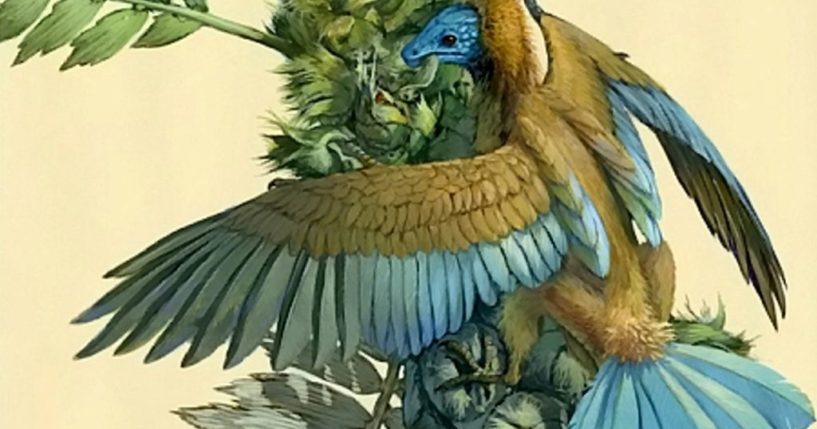
Jeholornis, A Creature From 120 Million Years Ago Was A Bird & Dinosaur Combo

A bizarre creature that lived 120 million years ago was a bird/dinosaur mix, according to new research.
Jeholornis had blue, brown and grey feathers, a long tail and small teeth – inherited from its reptile ancestors. Scientists have reconstructed its skull for the first time – revealing a brain made for smelling and eyes for daylight.

“The morphology is transitional, in between what we see in non-avian dinosaurs and what we see in modern birds,” said co-author Professor Matteo Fabbri of the Field Museum, Chicago.
“If you look at the skulls of dinosaurs, what you see is a spot for a very reptile-like brain, meaning they have very large olfactory bulbs, and the optic lobes in the midbrain are reduced. They probably had a very good sense of smell and not great sight, which is very reptilian. On the other hand, if you look at modern birds, they do the reverse. They have small olfactory bulbs, and very large optic lobes. Jeholornis falls in the middle.”

Raven-sized Jeholornis is the earliest known animal to eat fruit. The international team selected the best specimen unearthed from prehistoric graveyards in China. It was finely preserved and intact, but a little flattened by layers of sediment deposited across the ages.
“It is very difficult to find the right skull among around 100 fossils since we won’t know if one skull will provide us the information we want before the scanning,” said Dr. Han Hu, of the University of Oxford who is one of the authors of the new study of the Jeholornis.

“Due to the costs of high-quality scanning, we couldn’t scan all those specimens to choose the best one. However, I chose this one because at least from the exposed surface, it is relatively complete. What is also important is this skull is isolated from other parts of its body. This is very helpful since we usually won’t chop the skull off from the skeleton if they are articulated.
“No one wants to hurt these previous fossils, but an isolated skull will reduce the size of the scanning area, which will increase the scanning quality a lot.
“Luckily, the specimen we chose here for this project is nearly a perfect one – it provided us with so much unknown information after the digital reconstruction.”
The study provides the first accurate depiction of Jeholornis – showing it was among the earliest examples of dinosaurs evolving into birds.
“Jeholornis is my favorite Cretaceous bird. It has a lot of unusual, primitive traits, and helps shed light on the bigger story of how different birds evolved. This study is the first time we are really getting at what this bird’s skull looked like, what its brain must have been like, which is really exciting,” said co-author Prof Jingmai O’Connor, from the Field Museum.
With remains smashed flat, no one has been able to get a good look at Jeholornis – until now.
“These bones were kind of like the bottom of a bag of potato chips – they weren’t completely crushed, but the pieces were compacted,” explained Prof O’Connor. Further adding that, “we were able to CT scan them – essentially taking a bunch of X-rays and stacking them together to form a 3D image – and then digitally re-articulate them and reconstruct the skull from all these bones.”

Knowing the shape and dimensions of a fossil bird’s skull tells us a lot about its brain – like how a glove gives a decent approximation of a hand. What’s more, brain structures are conserved across species over time. Olfactory bulbs and the cerebellum are in the same general spots in a frog, a human or a fossil bird.
“We were able to see different features of the skull that had never been seen before in Jeholornis, and we were even able to extrapolate what its brain looked like,” said Dr. Fabbri, “Jeholornis had bigger olfactory bulbs than most modern birds, meaning it probably relied more on smell with a few exceptions such as vultures.”
“As fruits ripen, they release lots of chemicals. Having a better sense of smell might have helped Jeholornis find fruit,” said Prof O’Connor.
Birds have bones called scleral rings that help determine how much light goes into their eyes. Nocturnal species like owls have wider openings relative to their eye sockets. Birds active during the day have narrower ones, like Jeholornis.
The skull features described in Zoological Journal of the Linnean Society shed fresh light on the primitive bird’s lifestyle and place in the ecosystem.
“Reconstructing a skull is painstaking work, and as people are starting to put in the time to do it, it is becoming more and more clear the evolution of birds was more complicated than what we expected. It is not just different from dinosaurs and modern birds, it is different from other early birds too. It is not a straightforward evolutionary story. So when we look out the window at our feathered friends, we are actually watching dinosaurs,” said Dr. Fabbri.
“The same as Jingmai, Jeholornis is also one of my favorite birds,” added Dr. Hu. “Its special position as one of the most primitive birds during the dinosaur-bird transition determines completing its story will reveal the true scenery of that critical evolutionary period, and also, tell us why and how the modern birds – the only living dinosaurs – evolved to be what we see now.”
Produced in association with SWNS Talker.
The Western Journal has not reviewed this story prior to publication. Therefore, it may not meet our normal editorial standards. It is provided to our readers as a service from The Western Journal.
Truth and Accuracy
We are committed to truth and accuracy in all of our journalism. Read our editorial standards.
Advertise with The Western Journal and reach millions of highly engaged readers, while supporting our work. Advertise Today.










